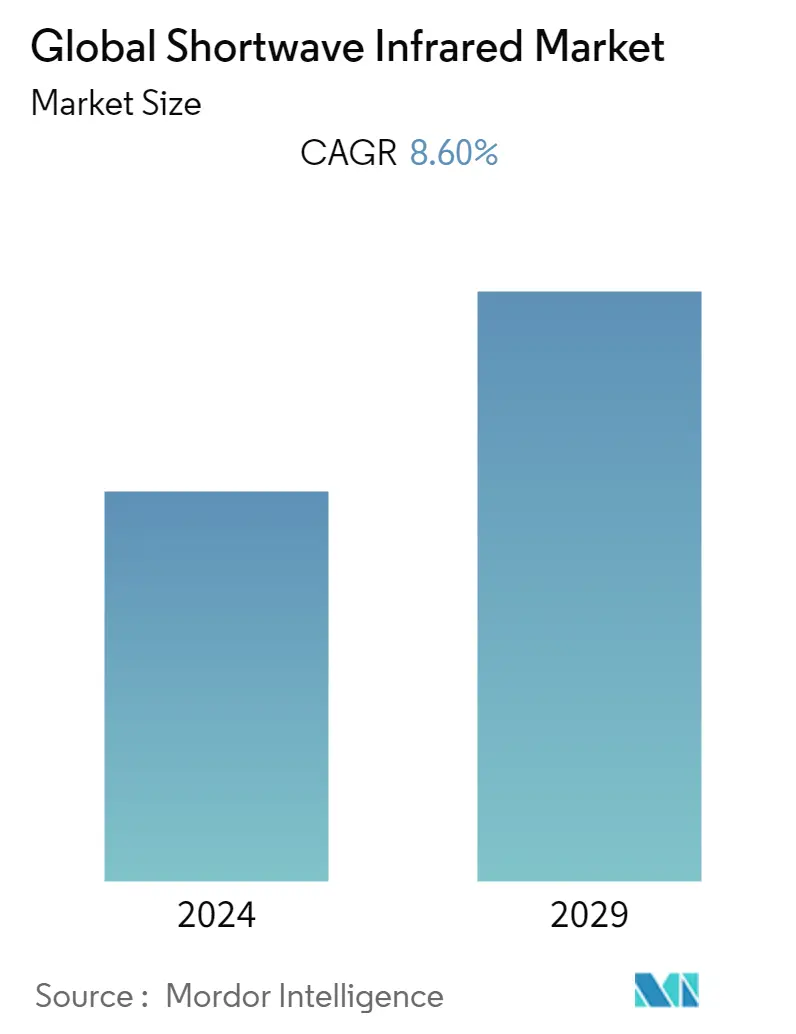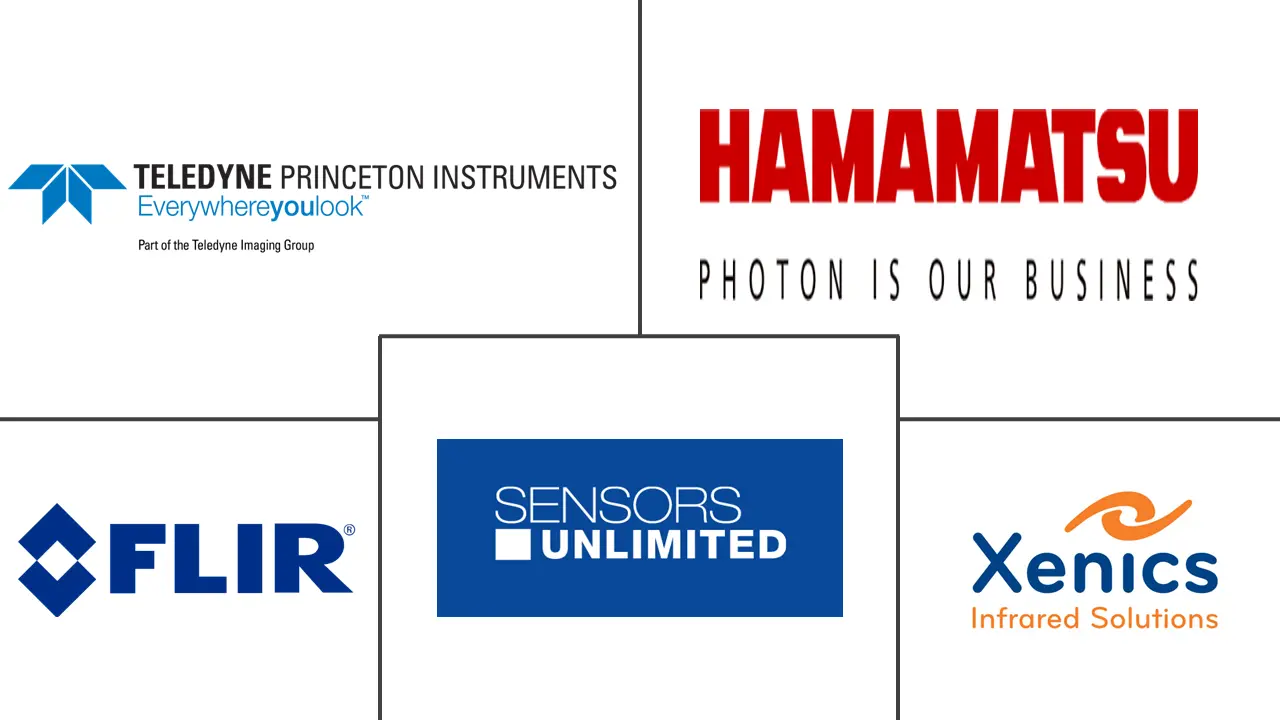Market Size of Global Shortwave Infrared Industry

| Study Period | 2019 - 2029 |
| Base Year For Estimation | 2023 |
| CAGR | 8.60 % |
| Fastest Growing Market | Asia Pacific |
| Largest Market | North America |
| Market Concentration | Medium |
Major Players
*Disclaimer: Major Players sorted in no particular order |
Shortwave Infrared Market Analysis
The Shortwave Infrared Market is anticipated to register a CAGR of 8.6% during the forecast period. The increasing applications of the technology across several end-user industries are driving the market. The applications are not limited to defense and healthcare, as shortwave infrared technology is increasingly adopted into the automotive sector owing to the rising demand for ADAS.
- SWIR is used for testing purposes in various industries, such as semiconductor manufacturing. Along with this, the increasing need for miniaturization and low-power consumption technology across defense applications positively influences the market.
- Favorable government initiatives aimed at military and defense equipment upgrades are expected to drive the SWIR market during the forecast period. Increasing applications in scientific research for surveillance and object detection also support the growth of this market. Also, the growing demand for SWIR products for monitoring and inspection application is expected to drive market growth. The primary advantage of using SWIR technology in military applications is that SWIR cameras can see through and image higher contrast images and provide data even through the mist, rain, and challenging atmospheric conditions.
- SWIR cameras have emerged to provide surveillance for securing risky zones. They can be mounted on buildings, trucks, and unmanned aerial vehicles and can detect any human activity or threats. Moreover, such cameras are adopted by geologists for studying several physical aspects of the earth.
- Additionally, SWIR has the advantage of low power consumption and can sense temperature, making it useful for detecting fires. A shortwave infrared sensor on the Earth Observation satellite from DigitalGlobe (an American commercial provider of space imagery and geospatial material) can see through dense smoke clouds from burning objects on the ground.
- SWIR cameras are being used more frequently for vehicle navigation. As driverless vehicles become more common, SWIR technology can aid in navigating through fog, snow, dust, and rain. Due to the expanding use of SWIR cameras in autonomous vehicles, the Israeli firm TriEyeintends to create a SWIR camera for the dashboard of consumer cars that can successfully navigate through snow, fog, dust, and rain.
- However, COVID-19 has caused a setback in the development of autonomous cars in the automotive industry as the global lockdown has impacted the testing of autonomous vehicles. Also, with the implementation of remote working, it is estimated that urbanization in most countries is decelerating as more people move to rural and suburban areas. This is causing testing and utilization challenges for Autonomous vehicles which delays their development and rollout time, hampering the growth of the studied market.
Shortwave Infrared Industry Segmentation
The Global Shortwave Infrared Market is segmented by Technology (Uncooled and Cooled), Product Type (SWIR Area Cameras and SWIR Linear Cameras), End-user Industries (Defense and Military, Healthcare and Research, Automotive, and Other End-User Industries), and Geography.
| By Technology | |
| Uncooled | |
| Cooled |
| By Product Type | |
| SWIR Area Cameras | |
| SWIR Linear Cameras |
| By End-User Industries | |
| Defense and Military | |
| Healthcare & Research | |
| Automotive | |
| Other End-user |
| Geography | ||||||
| ||||||
| ||||||
| ||||||
|
Global Shortwave Infrared Market Size Summary
The shortwave infrared (SWIR) market is poised for significant growth, driven by its expanding applications across various industries. This technology is increasingly being integrated into sectors beyond its traditional domains of defense and healthcare, notably in the automotive industry, where it supports the development of advanced driver-assistance systems (ADAS). The demand for SWIR technology is further bolstered by its utility in semiconductor manufacturing and the growing need for miniaturization and low-power solutions in defense applications. Government initiatives aimed at upgrading military and defense equipment are also expected to propel market growth. Additionally, the use of SWIR in scientific research for surveillance and object detection, as well as its advantages in monitoring and inspection applications, contribute to its rising adoption. The ability of SWIR cameras to operate effectively in challenging atmospheric conditions, such as fog and rain, enhances their appeal for military and security applications.
The North American region is anticipated to hold a significant share of the SWIR market, supported by its robust automotive and defense sectors. The United States, with its substantial defense budget, presents a lucrative market for SWIR technology. The region's market is further strengthened by the presence of major vendors engaged in research and development to advance SWIR technology. Companies are actively launching innovative products to meet the evolving demands of various sectors, including industrial inspection, art inspection, and astronomy. Collaborations, such as the one between TriEye and Toshiba Teli, aim to commercialize SWIR cameras for industrial applications, highlighting the technology's versatility. Despite challenges posed by the COVID-19 pandemic, which affected the testing and development of autonomous vehicles, the market continues to evolve, with significant investments and advancements in SWIR technology.
Global Shortwave Infrared Market Size - Table of Contents
-
1. MARKET DYNAMICS
-
1.1 Market Overview
-
1.2 Value Chain / Supply Chain Analysis
-
1.3 Industry Attractiveness - Porter's Five Force Analysis
-
1.3.1 Bargaining Power of Suppliers
-
1.3.2 Bargaining Power of Buyers
-
1.3.3 Threat of New Entrants
-
1.3.4 Threat of Substitute Products
-
1.3.5 Intensity of Competitive Rivalry
-
-
1.4 Market Drivers
-
1.4.1 Increasing Applications across End-user Industries
-
1.4.2 Need for Miniaturisation and Low-power Consumption Technology
-
-
1.5 Market Restraints
-
1.5.1 High Cost of SWIR Cameras and Detectors
-
-
1.6 Impact of COVID-19 on the Market
-
-
2. MARKET SEGMENTATION
-
2.1 By Technology
-
2.1.1 Uncooled
-
2.1.2 Cooled
-
-
2.2 By Product Type
-
2.2.1 SWIR Area Cameras
-
2.2.2 SWIR Linear Cameras
-
-
2.3 By End-User Industries
-
2.3.1 Defense and Military
-
2.3.2 Healthcare & Research
-
2.3.3 Automotive
-
2.3.4 Other End-user
-
-
2.4 Geography
-
2.4.1 North America
-
2.4.1.1 United States
-
2.4.1.2 Canada
-
-
2.4.2 Europe
-
2.4.2.1 Germany
-
2.4.2.2 United Kingdom
-
2.4.2.3 France
-
2.4.2.4 Rest of Europe
-
-
2.4.3 Asia-Pacific
-
2.4.3.1 China
-
2.4.3.2 Japan
-
2.4.3.3 India
-
2.4.3.4 Rest of Asia-Pacific
-
-
2.4.4 Rest of the World
-
2.4.4.1 Latin America
-
2.4.4.2 Middle-East & Africa
-
-
-
Global Shortwave Infrared Market Size FAQs
What is the current Global Shortwave Infrared Market size?
The Global Shortwave Infrared Market is projected to register a CAGR of 8.60% during the forecast period (2024-2029)
Who are the key players in Global Shortwave Infrared Market?
Flir Systems Inc., Hamamatsu Photonics K.K., Sensors Unlimited, Teledyne Princeton Instruments and Xenics are the major companies operating in the Global Shortwave Infrared Market.

